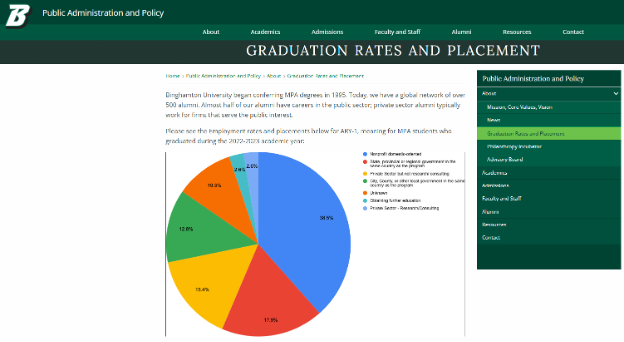Widgetized Section
Go to Admin » Appearance » Widgets » and move Gabfire Widget: Social into that MastheadOverlay zone
Accreditation That Works: NASPAA’s Approach to Strengthening Public Service Education
The views expressed are those of the author and do not necessarily reflect the views of ASPA as an organization.
By Martha Bohrt
June 20, 2025
Public service relies on an increasingly multi-sectoral workforce to meet public needs and solve pressing problems. In 2009, the NASPAA accreditation standards were revamped to emphasize the competencies essential for effective public sector leadership. In 2019, these standards were further refined to ensure students are trained to deliver effective governance, act with transparency and accountability and actively promote civic engagement. The result is an accreditation process grounded in transparency and aligned with measurable educational outcomes. NASPAA’s accreditation standards ensure that programs remain responsive, rigorous and relevant to today’s public service challenges.
Since its inception, NASPAA accreditation has been mission-based and developmental in nature. Our goal is to ensure that programs are managed professionally to reach learning outcomes and prepare populations as planned in each program’s mission. While a negative accreditation decision is possible when programs do not demonstrate optimal student achievement outcomes, NASPAA’s developmental approach prioritizes continuous improvement. Our accreditation Commission and site visitors evaluate whether accredited programs effectively fulfill their mission and uphold public sector values, ensuring that students benefit from the program’s contributions to their professional development. Our programs can also get re-accredited with monitoring. This means that the Commission will reaccredit them with conditions that they report annually on improvements on certain areas.
For example, if a program meets our standards but has less than optimal career placement rates or graduation rates, we require them to come up with a plan to improve their career placement rates or graduation rates, to report annually on progress and, if adequate improvement is not demonstrated, the Commission has the power to bring the program back into the accreditation cycle to ensure progress toward student outcomes achievement.
Ensuring Educational Quality
Retention rates are a key indicator of whether academic programs are meeting students’ needs. They reflect not only academic quality but also how well institutions support and engage students throughout their educational journey. High retention suggests effective teaching, strong advising and an institutional culture that prioritizes student success. For instance, nearly 60%, or 119 of 207 NASPAA-accredited programs, have retention rates over 90%. In addition, 55% of our programs have reported improvement in their graduation and retention rates in their last 7-year accreditation cycle. It is fair to say that almost all our programs start at a high retention and graduation rate or attain a high rate within their 7-year accreditation cycle.
The graph below illustrates retention rates for three NASPAA-accredited programs (A, B and C) over recent report years. All three programs show consistent improvement, with Program C nearing 95% by 2022. This upward trajectory underscores how accreditation fosters programmatic practices that help more students persist to graduation.

Value and Return on Investment
Employment rates are one of the most concrete indicators of the value of an academic program. When graduates are consistently able to secure jobs in their field, it signals that the program is equipping them with relevant skills, knowledge and preparation for the workforce. These outcomes are especially important in a higher education environment where students increasingly demand evidence of return on investment.

Almost 90% of our accredited programs have employment rates higher than 80% and 67% have employment rates higher than 90%. The average career placement rate of our graduates is 91% and more than half of our accredited programs have a placement rate higher than 93%. The average placement rate of university graduates in the US is around 80%. So clearly the emphasis on return on investment in our accredited programs has paid off.
Furthermore, our developmental approach has helped in improving our programs’ placement rates during their last 7-year accreditation cycle. More than half of our programs have shown improvement in their placement rate during their last 7-year accreditation cycle.
The following graph tracks employment outcomes for three other NASPAA-accredited programs (D, E and F). Notably, Program D demonstrated a steep climb in employment outcomes from 23% in 2020 to over 75% in 2024. Programs E and F consistently exceed 80%, with E reaching 95% by 2024. These trends reinforce how NASPAA’s focus on preparation for the workforce helps programs strengthen career readiness and meet students’ expectations for a return on investment.
Accountability and Transparency
Accountability and transparency are vital to program integrity. When programs are open about key metrics like graduation rates, time-to-degree and employment outcomes, students can make informed choices. Transparency also supports continuous improvement by helping programs identify strengths and areas for growth. Crucially, reporting disaggregated data allows programs to address equity gaps and ensure all students are being served effectively.
The screenshot below illustrates how a program publicly shares employment outcome data for its graduates. By making this information accessible, the program demonstrates its commitment to transparency and provides stakeholders with valuable insights into the career trajectories of recent alumni.

NASPAA Accreditation demonstrates that accreditation can promote innovation, accountability and real-world relevance without becoming bureaucratic or ideological. By focusing on retention, employment outcomes and transparency, NASPAA-accredited programs show that it is possible to measure what matters, ensuring that graduates are not only prepared to serve but equipped to lead.
Author: Martha Bohrt is the Interim Executive Director of the Network of Schools of Public Policy, Affairs and Administration (NASPAA), the global standard in public service education. She leads NASPAA’s efforts to advance excellence in public service education through accreditation, advocacy and global engagement. She can be reached at [email protected]. More information is available at www.naspaa.org.







Follow Us!